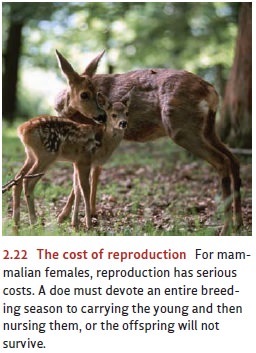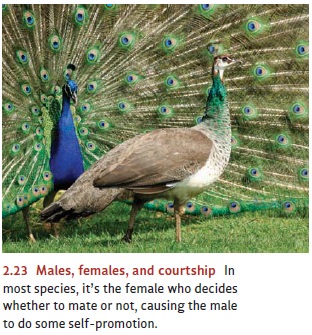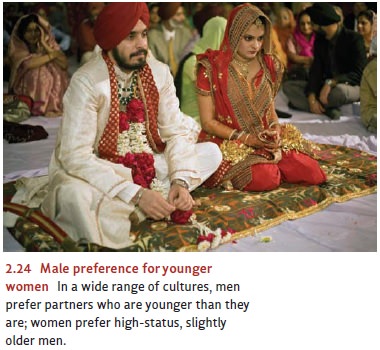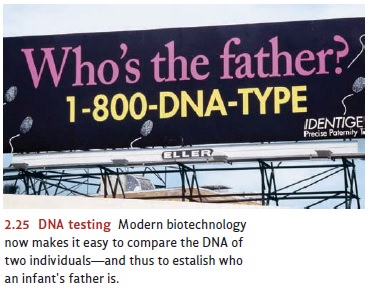Chapter: Psychology: The Genetic and Evolutionary Roots of Behavior
The Evolution of Mating Patterns
The Evolution
of Mating Patterns
In the case of intelligence, our
main emphasis was on proximate causes and, in partic-ular, the relatively high
heritability of intelligence in many circumstances. In other cases, we know
much less about proximate causes but more about ultimate causes— the function of a behavior and the reasons it
evolved. Some of the clearest examples in this latter category concern an
important topic for natural section—selecting and attracting a mate.
MATING SYSTEMS
In many species, the partners
remain together after mating for a breeding season or even longer. In some
species, the resulting relationship is monogamy—a
reproductive part-nership between one male and one female. In other species,
the arrangement involves polygamy; that
is, several members of one sex mating with one individual of the other.This
arrangement can involve either polygyny,
several females mating with one male, or polyandry,
several males mating with one female.
What accounts for these different
mating systems? A clue comes from a difference in the patterns found in mammals
and in birds. Some 90% of birds form enduring social bonds with just a single
mate. In contrast, more than 90% of mammals are polygamous: one male mates with
a number of females, or (in some species) one female mates with several males.
These observations can easily be understood in terms of ultimate (i.e.,
evolutionary) causes, which hinge on what an organism can do to maximize its
reproductive success.
Let’s start with the problem
faced by birds. In many species, successful incubation of the eggs requires
both parents—one to sit on the eggs and keep them warm, and the other to forage
for food to nourish the bird that’s sitting. Then, after the hatching, finding
food for a nestful of hungry chicks may still require the full-time efforts of
both birds. Under these circumstances, monogamy makes reproductive sense for
both the male and female. Each parent needs its partner’s continuing help;
otherwise, no chicks—and so none of their genes—will survive.
The situation is quite different
for most mammals. Here there’s no issue of tending the nest, because there is
no nest. Instead, the fetus grows within the mother’s uterus, allowing her to
continue foraging for food during the offspring’s gestation. Then, after birth,
only the mother can secrete the milk needed to feed the young. Thus, strictly
in terms of physical needs, the father is unnecessary after conception. The
young can often survive under the mother’s care alone, and so the male’s genes
will be carried into the next generation whether he’s in attendance or not.
Let’s also bear in mind that the
more offspring a creature has that survive to maturity and reproduce, the
better represented its genes will be in the next generation. By this logic,
“success” in an evolutionary context often means having as many surviving
off-spring as possible. Therefore, to maximize his reproductive success, the
male mammal should mate with one female and move swiftly to the next, operating
on the idea that the more females he mates with, the more children he’s likely
to father. There’s no need to stick around after mating, to care for his
offspring, because the young will probably sur-vive without him.
Females need a different approach
to mating to make sure their genes are transmit-ted into the next generation.
They don’t have the option of having dozens of offspring, because they need to
invest considerable time and resources carrying and then nursing each of their
progeny. As a result, females maximize their reproductive success by mating
just a few times during their lives—but ensuring the health and well-being of
each of their young. From an evolutionary perspective, this is a key reason
females usually prefer fewer partners than males do.
This logic allows us to explain
the mating patterns of walruses, bison, wolves, and most other mammals—in each
case, the males choose to mate with multiple females, while females prefer few
partners, and perhaps just one. Does the same logic apply to humans? If it
does, then humans should also have a tendency toward polygyny—and they do. One
survey examined 185 different cultures worldwide. Only 16% of these required
monogamous marital arrangements (for the classic data, see Ford & Beach,
1951). The vast majority of traditional, unindustrialized cultures allow (or
even encourage) polygyny.
It does seem plausible, then,
that evolutionary pressures have selected for the sexes’ different attitudes
toward mating. Perhaps the difference between the sexes is then reinforced by
learning, and also shaped by cultural norms. After all, young boys in many
cultures are taught that sexual conquests prove their “manliness,” while girls
are taught to value home, family, and a dependable partner. This, too, might
explain why men end up preferring more partners than women do.
Thus, we might have an evolved tendency supported by learning—so that each mechanism reinforces the other. In addition, we need to ask why the cultural pattern takes the form that it does: Why do cultures convey certain expectations to boys and different expectations to girls? Our explanation will likely draw us once again to considerations of natural selection. Clearly, the evolutionary account—describing the ultimate cause of these mating preferences—is likely to be a key part of how we think about this comparison between the sexes.
WHICH MATE DOES THE CHOOSING ?
The process of natural selection
has other implications for mating. For example, in most species of mammals,
it’s usually the female who makes the final choice of whether to mate or not.
The biological reasons for this pattern are straightforward: Reproduction puts
a huge burden on a mammalian female—something that we can measure either in
terms of the energy cost of carrying and then nursing her offspring or in terms
of sheer amount of time she must invest in her young. For a doe’s offspring to
survive, for example, she has to devote an entire breeding season to carrying
the young and then nursing them. As a result, she can have only one or two
fawns per year—and so she has only one or two chances each year to transmit her
genes to the next generation (Figure 2.22).

On this basis, evolution would
have favored females who were quite careful in their choice of reproductive
partners. For them, reproduction is a serious business with heavy biological
costs; they need to get it right and choose a mate who will be the best father
possible—one who will contribute healthy genes and provide resources and support,
thus making it much more likely that the young will survive.
What about the male’s point of
view? In most species, he needs only a few minutes for mating with the female
and must commit just a few easily replaced sperm. Then he can unconcernedly go
about his business, perhaps to impregnate the next female a short time later.
For males, reproduction is not costly—and so it matters less whether they
choose their partners carefully. Indeed, if they want to maximize their number of partners, males cannot be too
selective.
This line of thinking suggests
that natural selection would have favored females who were extremely careful
about their mate choices and males who were not. And this is the pattern of the
data—because, as we’ve said, in many species it’s the female who chooses
whether to mate or not. As it turns out, there are exceptions to this broader
pattern—but these too can be understood in evolutionary terms. For example,
consider the sea horse, whose young are carried in a brood pouch by the male.
Since the male makes the greater reproductive investment, he correspondingly
exhibits greater sexual discrimination than the female. The same story applies
to phalaropes—arctic seabirds whose eggs are hatched, and whose chicks are fed,
by the males. For these birds, a
greater part of the biological burden falls on the male. We should expect males
to show a corresponding increase in sexual choosiness—and that’s just what
happens. Among the phalaropes, the female does the wooing and the male does the
choosing (G. Williams, 1966).
A related evolutionary argument
applies to the difference between males’ and females’ roles in courtship. If it’s the females who do
the choosing, then the burden falls on the males to attract and persuade their
potential partners. This explains why, in many species, the male is brightly
colored while the female’s fur or plumage is relatively drab; similarly, in
many animals the male has conspicuous anatomic features (such as striking
antlers or an extraordinary tail) that the female lacks. Since the female makes
the decision, the male needs to do some self-promotion (Figure 2.23).
Females take notice of these
various displays and structures because they show off the males’ size, health,
and strength. In fact, many studies confirm that the males’ displays really do
persuade females. For example, in one species of widow birds, the

males have tail feathers that are
up to 20 inches long. To study the importance of this trait, an unsympathetic
investigator cut the tails on some males and placed feather extensions on
others. After a suitable period, the investigator counted the number of nests
in each bird’s territory. The males whose tails were cosmetically extended had
more nests than did the unaltered males, who in turn had more nests than their
unfortunate fellows whose tails had been shortened (Andersson, 1982). It does
pay to advertise.
HUMAN MATE CHOICE
In our species, both males and
females are selective in choosing their sexual partners, and mating happens
only when both partners consent. However, the two sexes differ in how they make their choices. Data
indicate that while both sexes value physical appear-ance, on average, men care
more than women do about their partner’s attractiveness. Conversely, women
typically care more than men do about their partner’s social status—women
prefer higher-status males. Men also tend to prefer women younger than themselves,
while women tend to prefer men who are slightly older. The data also indicate
that these male–female differences are found throughout the world in coun-tries
as diverse as China, India, France, Nigeria, and Iran (Figure 2.24; D. Buss,
1989, 1992; D. Buss & Barnes, 1986). Quite interestingly, though, the two
sexes agree on one point: Across cultures, both men and women value kindness
and intelligence in their prospective mates (D. Buss, 1992).

According to David Buss, the
investigator who uncovered many of these results, the best explanation is
evolutionary—hinging, once again, on the ultimate causes of these behaviors.
Specifically, if our male ancestors preferred attractive women, Buss argues
that this preference would have increased their reproductive success because
attractive women are likely to be healthy and fertile. As a result, natural
selection would have favored males with this preference, and so the preference
would have become wide-spread among the males of our species. Likewise, the
younger a woman is, the more reproductive years she’s likely to have ahead of
her. A male who selects a younger part-ner is therefore likely to end up with
more offspring. Again, this preference would increase the male’s reproductive
success—and so the preference would have been favored by natural selection and
thus would become more common for the species.
The female’s preferences are also
easy to understand from this perspective. Because of her high investment in
each child, the female’s best bet is—as we’ve said—to have just a
few offspring and to do
all she can
to ensure each
child’s survival. Having a healthy mate would be helpful on this
score—so women too should seek out attrac-tive partners, based on the idea that
attractiveness is often an indi-cator
of health. Crucially,
though, women should
also prefer higher-status mates,
based on the expectation that these mates will be more likely to provide the
food and other resources the women’s children
will need. Thus, there’s a
reproductive advantage associ-ated with a preference for such a
male, so that over time, genes pro-moting this preference would become
increasingly common among females
in the species
(Bjorklund & Shackelford,
1999; D. Buss, 1992).
There are, to be sure, other
influences on sexual behavior and mate choice. Still, across a wide range of
cultures, each of the sexes shows great consistency in the attributes they seek
in a mate—exactly as predicted by an evolu-tionary perspective.
JEALOUSY
We’ve discussed several
intriguing claims about how natural selection has shaped human mating, but we
should note that these claims have been controversial. When Richard Alexander
(in 1974) and Edward O. Wilson (in 1975) began applying evolu-tionary logic to
human behavior, their work—then called sociobiology—attracted
both enthusiastic adherents and vehement critics. The debate has continued
regarding more recent work within a perspective called evolutionary psychology, which has impassioned advocates (D. Buss,
2009; Pinker, 2003; Tooby & Cosmides, 1990) as well as harsh critics (e.g.,
Buller, 2005; for a glimpse of the debate between these views, see D. Buss
Haselton, 2005; Cosmides, Tooby, Fiddick, & Bryant, 2005; Daly &
Wilson, 2005; Delton, Robertson, & Kenrick, 2006).
Let’s be careful, however, not to
overstate the disagreements. In particular, we need to avoid the trap of
“either-or” thinking—explaining a behavior either in terms of evo-lution
(ignoring cultural influences) or in terms of culture (ignoring evolution).
Instead, we need to remember always that human behaviors are influenced both by fac-tors rooted in our genes
(and so shaped by evolution) and by factors rooted in our expe-rience (and so
shaped both by culture and by our individual circumstances). Moreover, these
two broad categories of influence are—as we’ve repeatedly said—interdepend-ent:
Gene expression is influenced by our environment and experience, and the impact
of experience is dependent on the genetically shaped sense organs that let us
perceive the experience and on the genetically shaped brains that let us
understand and remem-ber the experience.
Even taking these complexities
into account, it’s undeniable that an emphasis on natural selection has been
fruitful for psychologists and has led to a host of new hypotheses about why we
act as we do. Many of these hypotheses have been powerfully confirmed through
careful data collection. For some further illustrations, let’s look at the
findings concerned with jealousy and fathering.
Jealousy is, of course, found in
men (as in Shakespeare’s Othello) and
women (as in the saying, “Hell hath no fury like a woman scorned”). But the
basis for jealousy in romantic relationships may be different in the two sexes.
According to several studies, men care more about sexual loyalty than emotional
loyalty; they think it’s worse for their partner to sleep with someone else
than to be emotionally engaged with someone else. For women, the data indicate,
the pattern reverses; women show greater concern about emotional disloyalty
than about sexual transgressions (D. Buss, Larsen, Westen, & Semmelroth,
2001; also Schmitt & Buss, 2001; for some concerns about these findings,
see Harris, 2002; DeSteno, Bartlett, & Salovey, 2002).
Once again, this pattern makes
sense in evolutionary terms. From this perspective, a woman may have less
reason to care if her mate has sex with others. For purposes of transmitting
her own genes into subsequent generations, all she needs is a single one of her
partner’s sperm cells to launch her pregnancy; once she is pregnant, it won’t
mat-ter how the male distributes his “surplus” sperm. What the female does need
from the male are the resources he provides to nourish both her and her young.
Without the resources, her young might perish—and, in evolutionary terms, this
would be a calamity. This is why a female feels deeply threatened when her
partner starts devoting his resources to other women (and their offspring), and
it’s why the female wants an emotional commitment
from her mate—so that he remains loyal to her and focused onher needs. Hence it
is her mate’s emotional disloyalty, not his sexual wanderings, that is most
threatening to the woman’s evolutionary self-interest.
What about men? If a man devotes his resources to a woman and her children, he needs to be sure that these children carry his genes and not someone else’s; otherwise, he’s spending his resources to promote another male’s legacy. On this basis, it should be very troubling for a male if his mate is sexually unfaithful; that would create doubts about the paternity of her offspring. Her emotional infidelity, on the other hand, is less worrisome: It is okay if his mate loves someone else, provided that her love doesn’t lead her to have sex with that someone else.
PATERNITY
A woman always knows for certain
that the babies she gives birth to are her biological offspring. Men, on the
other hand, don’t share this certainty and may sometimes question whether a
baby is their child (Figure 2.25). As we’ve seen, this point has implications
for men’s jealousy; it also has implications for how fathers care for their
young. For example, Platek and colleagues (Platek, Burch, Panyavin, Wasserman,
& Gallup, 2002; Platek, Raines, Gallup, Mohamed, Thomson et al., 2004)
photographed the faces of 20 undergraduate men and 20 undergraduate women. They
then used a photo-morphing computer program to blend each volunteer’s face with
that of an unrelated infant. The result was an image of a child that roughly
simulated what the volunteer’s own baby might look like.

The researchers then presented
each participant with photos of five children’s faces. None of the volunteers
knew that one child’s face was a blend with their own face; the other four
faces were blends with other adults’ faces. The researchers then asked, among
other questions, “Which one of these children would you adopt?”
From an evolutionary perspective,
men should be quite sensitive to issues of pater-nity; and so they should have
a preference for babies who resemble them, because the resemblance would
suggest biological relatedness. And in fact, 18 of the 20 men tested picked
“their” child—the photograph that had been morphed with their own face. Women,
on the other hand, should be less sensitive to biological relatedness because,
as we have described, this has not been a concern for them over the course of
human evolution. The study results were consistent with this idea; only 7 of
the 20 women picked “their” child.
Another result is more dramatic
and—potentially—deeply consequential. From an evolutionary perspective, males
should take care of their own young (and so protect their genetic legacy) but
should not take care of other men’s young—including others’ young that might be
raised by their mates. In the modern world, therefore, we would expect an
evolved tendency for males to favor their biological children over their
stepchildren. This favoritism might, in many fathers, be overruled by other
considera-tions; and so many stepfathers will be loving, generous, and
supportive to their adopted children. Even so, the biologically rooted tendency
should still be detectable in a variety of ways. Indeed, let’s look at the
extreme: What if the father is inclined to violence? If, as a horrific
prospect, he harms his children, which ones will he harm?
Daly and Wilson (1988) gathered
data on the most extreme, most horrible parental crime: infanticide. They
examined cases of this offense in Canada between 1974 and 1983 and found that
children under the age of 2 were killed by stepparents at 70 times the rate
they were killed by biological parents. To be sure, the overall rate of infanticide was quite low, and very few stepparents
com-mitted this terrible crime. Still, the probability of this crime was much
higher for stepparents than for biological parents.
Once again, though, we need to
acknowledge the room for debate. The intriguing finding that men preferred
“their own” baby’s photo far more often than women did comes from a study of a
small sample of college students. It would surely be helpful to know whether
results from much larger groups and across cultures support the evolutionary
interpretation of the data. Likewise, the Daly and Wilson data have been
controversial (for reviews, see Daly & Wilson 2001, 2005, 2007). Among
other issues, the findings are observational, not experimental, and this makes it difficult to establish cause
and effect. We therefore need a bit of caution in interpreting these findings;
but this takes nothing away from the fact that the evolutionary perspective,
here and in many other realms, has uncovered some truly striking results. It’s
now up to subsequent researchers to nail down our best explanation of these
findings.
Related Topics